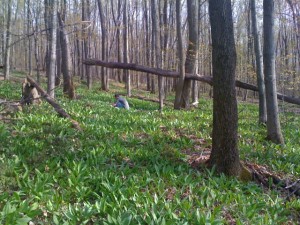Ground Hog Day marked the start of the new growing season, but spring began in earnest the second week in March with a flurry of outdoor activity during a welcome thaw.  Maple sap flowed freely in the warm sunshine, the ducks began laying daily eggs, and it was planting time indoors and in the hoop house.
Even after chilly temperatures returned this week, vernal colors remain with over-wintered greens putting out new growth along with daffodils blooming in the hoop house. Â Forsythia branches kept in a vase on the kitchen table popped open their yellow blossoms soon to be followed by soft salmon pink of the flowering quince.
So while winter comes and goes in March and continues into April, gardeners can feed their souls and coax early harvests by steadily exploiting every opportunity to maximize the growing power of spring sunshine. Â Here’s my monthly to-do list of gardening tasks to help you cherish the on-and-off, Northern version of spring.
MARCH
- Set up an indoor seed starting system if you haven’t already, providing supplementary light if possible.
- Start seeds for celeriac, peppers, eggplants, and basil indoors along with any herbs or flowers that need a long season (many people start the latter along with any onion family starts in February)
- Prepare soil under cover (cold frame, hoop house, etc) as soon as ground thaws, in any empty places and seed hardy greens.
- Plant peas and fava beans under cover amongst the overwintered lettuce and spinach, so the new plants can take over as soon as the greens are done.
- Water, weed and harvest under-cover, any over-wintered greens and herbs as they put out new growth.
- Cover a bed or garden area with plastic to melt snow and dry it for early planting.
- Graft and prune fruit trees, shrubs and vines
APRIL
- Prepare soil and direct-seed all hardy plants (spinach, lettuce, peas, cabbage family, onion family, carrots, beets, etc.) in garden as soon as soil can be worked.
- Mulch plants that are under cover as temperatures warm to keep roots moist and prevent overheating
- Harvest greens at a steadily increasing rate.
- Remove plants that are under cover as they bolt unless you want them to seed themselves, and plant new crops (potato sets can handle surprisingly cold soils), transitioning to increasingly tender crops as season progresses.
- Start tomato seeds indoors under lights
- Remove mulch from asparagus and rhubarb to warm soil
- Apply compost and mulch to root zone of fruit trees
- Transplant woody plants and perennials if soil is no longer wet
- Harvest dandelion leaves and roots before the plant flowers.
- Head into woods to look for morels and large patches of wild leeks (places where you can harvest sustainably)
MAY
- Transplant tomato seedlings and other transplants to larger pots, burying any leggy stems to encourage strong root growth.
- Add good quality compost to all garden beds to improve soil texture, fertility and reduce disease
- If possible, prepare beds for summer plants at least a week or two before you plant.
- Direct seed root crops and hardy greens in early May.
- Direct seed or plant in pots, long-season cabbages and brussels sprouts for winter storage
- Plant potatoes early as well as onion-family plants and sets
- Plant squash, cucumbers and other warmth-loving plants (those with with large seeds) in pots if you want – otherwise wait and plant directly in the soil when it warms.
- Harvest lettuce, greens, radish, chives from earlier plantings and sorrel, rhubarb and asparagus from perennial plantings
- Forage for pheasant back mushrooms young nettles, wild leeks and other spring greens.
- Transplant woody plants and perennials
- Transplant tender plants (tomatoes, peppers, eggplants, basil, squash corn, beans etc.) into ground when soil & air are consistently warm – maybe at the end of May but often best to wait until June. Â Remember the rule of thumb: don’t plant until you can comfortably sit on the soil with a bare bum!
Every season and every garden are unique and every gardener has a different routine so I offer this schedule only as a guide to help you find your own groove. Â Happy Spring!



Leave a Reply